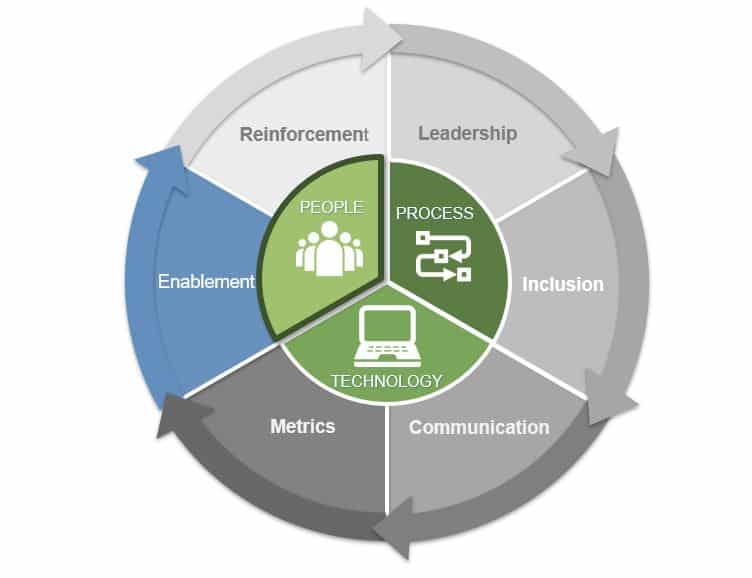In our article, Six Key Principles of Successful Change Management, we introduced the principle of metrics and the importance of establishing meaningful goals and measuring progress toward them to drive your desired business outcomes.

Traditional change management metrics focus on training consumption, but more information is available to measure adoption. In this article, we will explore key areas to consider when determining KPIs related to system implementation, such as an ERP or EHR, and how to define success.

How will you assess training effectiveness?
Training effectiveness and efficiency can be tricky. Training consumption is a popular statistic but typically measures “butts in seats,” which doesn’t consider comprehension, enablement, or usability. Without the additional measures, you won’t have enough data to measure the ROI of the delivered training. Measurements to consider for training effectiveness:
Consumption
Measure the number of people who have completed training against the number of people targeted to complete training.
Comprehension
Do people understand the training? This measure can be determined by including an assessment after coursework completion to ensure training objectives are met.
Enablement
Does the knowledge gained from training enable your people to use the system properly? After training, send post-training surveys to the trainees to gauge their confidence in using the new system.
Usability
Post-implementation is an ideal time to survey team members about the value of the training content and the timeliness of delivery. Feedback will contribute to refining content for new employee training.
How will you determine system usage and operational efficiency?
After implementation, your KPIs can include tracking usage metrics to understand how effective the system is working for the organization. System logins and business process utilization are the two key areas.
- System logins – How many, how frequently, and how users log into the system (mobile or laptop).
- Business process utilization – How long it takes to perform business processes or tasks in the new system compared to the old system to achieve greater efficiency.
How will you assess organization engagement?
To ensure a smooth transition and buy-in for the organization to the new ways of working, people need to be ready. By developing surveys, focus groups and conducting interviews, you will help gain insights into the engagement levels throughout the organization. To address engagement needs, leverage change champion networks and stakeholders for input and message delivery. Two-way communications will continue to drive engagement and ensure knowledge has been delivered.
What is your return on investment (ROI)?
ROI is generally defined as financial benefits compared to investment.
Financial ROI% = Program Benefits – Total Investment Total Investment * 100
This effectively measures the difference between the performance of snapshots in time – the legacy state and the future state. Change management is the process of what happens during the transition between the “now” and “then” and is measured by the increased efficiency of comprehension, consumption, usability and readiness.
The ability to quantify productivity is an important metric and should be included as a component of overall ROI. To determine ROI, you need to estimate and measure the transition from applying the new ways of working to not applying them. For leaders to adopt and lead by example, the metrics need to strongly demonstrate the value of employing the new methods.
Measures to compare include:
Leadership Commitment
The sponsor, steering committee and leadership team are engaged with, committed and visibly demonstrate support for the project and team.
Communications
The effectiveness of implementing a communications plan ensures stakeholders and users are informed of the impacts and understand how they affect them. It provides a forum to answer any questions about the new ways of working.
Employee Adoption
The speed of employee adoption is essential for project success. Creating personalized plans, transparency into expectations and addressing the “why” will allow employees to quickly move along the learning curve.
Training
Training must be designed and delivered to be an effective and efficient use of time. Equip the users to succeed by providing the right training to the right people at the right time.
Risk Mitigation
Risks are inherent in projects and are often revealed in the change management workstream. Identifying and mitigating potential risks reduce the potential for any obstacles which may affect the project goals.
How do you bring it all together?
Adoption metrics are not always easy to measure, but if you don’t define HOW you will measure success, you won’t be able to recognize the effectiveness of your change management investment fully. Determining the right metrics will provide insights into your organization’s intrinsic and explicit value.
If your organization needs help implementing change management, Impact Advisors offers seasoned consultants with experience building positive environments that enable your success.


